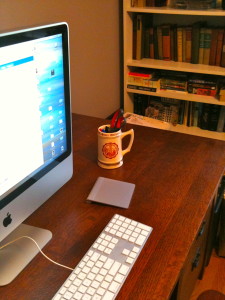
Apple’s Magic Trackpad was a birthday present from my spouse. Granted, I made it clear that it was at the top of the gift list, but he still gets high marks for sticking to the list. But I digress.
This is fabulous device. I can two-finger scroll. I can two-finger tap to generate a “right-click” response. I can three-finger drag. It’s all just grand, just like on my MacBook.The smooth glass surface is classic Apple design. The surface area is large enough to let your hand wander and make full gestures, but not so big as to be in the way. No more picking up the mouse to move it back when it gets too close to the edge! No more cramped hands! It was a dream as I was managing images in iPhoto, and great with detail work in Photoshop.
It uses Bluetooth, so one less cable on the desk. That’s not only less clutter to deal with logistically, but it certainly cleans up the look of the desk. The two AA batteries I started with on December 21 (yes, my birthday) are down to only 54% after more than a month of use — not only by me, but my daughter who shares the computer. You can use both the Trackpad and a mouse — it’s not an either/or choice. My daughter chose to plug in the traditional mouse for a homework assignment where the Trackpad was new enough that it was a distraction; when she took a break, I automatically started using the Trackpad again.
Is it perfect? Not quite. I haven’t yet mastered the click and drag. Pressing down with my thumb (click) while using moving another finger (drag) isn’t intuitive or comfortable. I’ve changed settings so that a quick double tap accomplishes the same thing, but that setting turns off the three-finger dragging that I very much like. (I do like how the Trackpad settings in System Preferences provide a short demo of each feature.) I’m also not sure what the environmental impact is of such a device compared to a mouse. Likely not a lot, but it does all add up. I also had to upgrade to Snow Leopard (v.10.6.4) which I wasn’t quite ready to do. So that was both a hidden cost and additional setup time. At $69, it’s a very expensive pointing device. But it is really so much more, and I can imagine that those with any sort of hand pain or limitations would find this to be a useful device.
The last drawback is that I don’t have one at work, and so my hand doesn’t know quite how to work properly when I’m sitting at the Dell. But I can live with that. I give this device two thumbs up! Or maybe that’s a three-finger swipe….